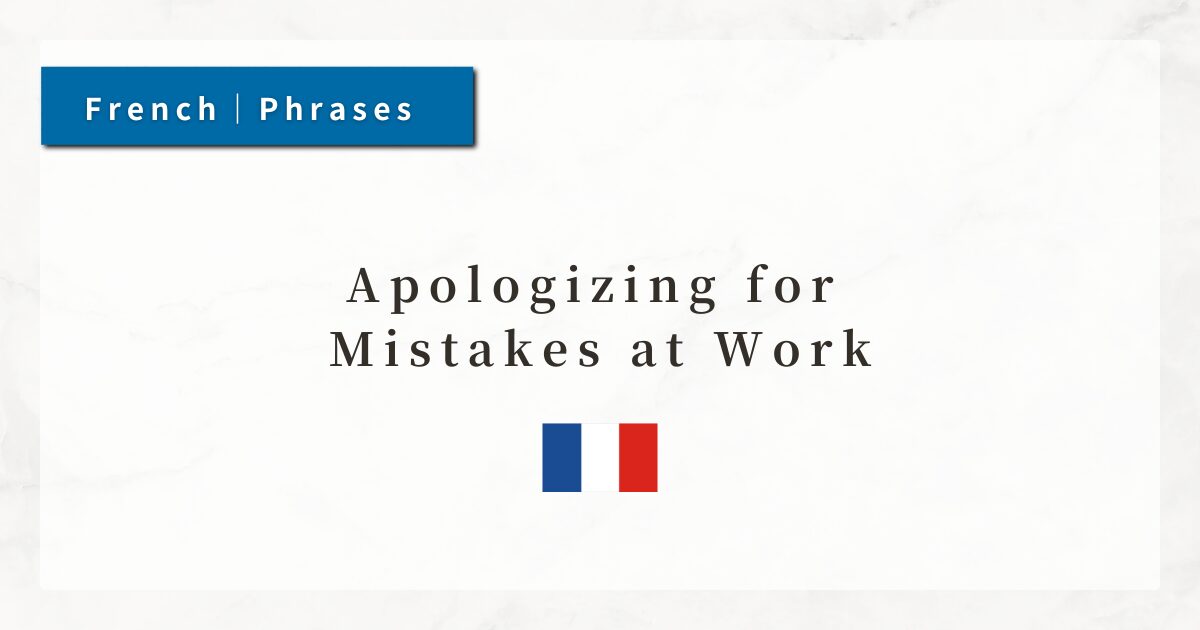#67 Apologizing for Mistakes at Work|French Business Conversation

In the workplace, everyone makes mistakes at some point. In such situations, it is important to apologize sincerely and, if necessary, communicate the measures you will take to prevent recurrence.
Being able to apologize appropriately in French shows sincerity and helps maintain trust in business relationships.
In this lesson, I will explain practical French expressions for apologizing in professional contexts, along with relevant grammar points.
Dialogue

j’aimerais m’excuser pour l’erreur dans le rapport.
(I would like to apologize for the mistake in the report.)

Oui, j’ai vu. Pouvez-vous m’expliquer ce qui s’est passé ?
(Yes, I noticed. Could you explain what happened?)

C’était une faute d’inattention. Je ferai plus attention la prochaine fois.
(It was a careless mistake. I will be more attentive next time.)

D’accord. Merci pour votre honnêteté.
(Alright. Thank you for your honesty.)

Encore désolé pour ce problème. Je m’assurerai que cela ne se reproduise pas.
(I sincerely apologize again for this issue. I will make sure it does not happen again.)
1. Basic Expressions for Apology and Nuance Differences
1-1. Je suis désolé(e). — I am sorry.
The most common way to express an apology. It can be used in both formal and casual contexts.
- Je suis désolé pour l’erreur.
(I am sorry for the mistake.)
If the speaker is female, add -e → désolée.
1-2. Je voudrais m’excuser. — I would like to apologize.
This is a more formal and polite expression, suitable for business situations.
- Je voudrais m’excuser pour le retard.
(I would like to apologize for the delay.)
Used in meetings, reports to superiors, or other formal contexts.
1-3. Pardon / Excusez-moi — Excuse me / Sorry.
Used for lighter mistakes or small inconveniences.
- Excusez-moi pour cette erreur.
(Sorry for this mistake.)
Not sufficient for serious errors; more appropriate for everyday interactions.
2. Explaining the Cause of the Mistake
Apologies alone may not be enough; it is important to briefly explain why the mistake occurred.
- C’était une faute d’inattention.
(It was a careless mistake.) - Il y a eu une erreur de calcul.
(There was a calculation error.) - J’ai mal compris l’instruction.
(I misunderstood the instruction.)
Keep the explanation honest and concise. Long justifications can have the opposite effect.
3. Expressing Measures for Prevention
To reassure the other party, it is necessary to show that the same mistake will not be repeated.
- Je ferai plus attention la prochaine fois.
(I will be more careful next time.) - Je vérifierai les données avant de les envoyer.
(I will check the data before sending it.) - Je m’assurerai que cela ne se reproduise pas.
(I will make sure it does not happen again.)
Providing concrete preventive measures conveys sincerity.
4. Expressions of Consideration for the Other Person
Ending with gratitude for the other person’s understanding or patience leaves a good impression.
- Merci pour votre compréhension.
(Thank you for your understanding.) - Je vous remercie de votre patience.
(Thank you for your patience.)
Apologizing and adding a note of appreciation reflects good business etiquette.
Summary
- Je suis désolé(e).
→ Standard apology. - Je m’excuse / Je voudrais m’excuser.
→ More formal and polite apologies. - C’était une faute d’inattention.
→ Briefly explain the cause. - Je ferai plus attention … / Je m’assurerai …
→ Express preventive measures. - Merci pour votre compréhension.
→ End with appreciation.




